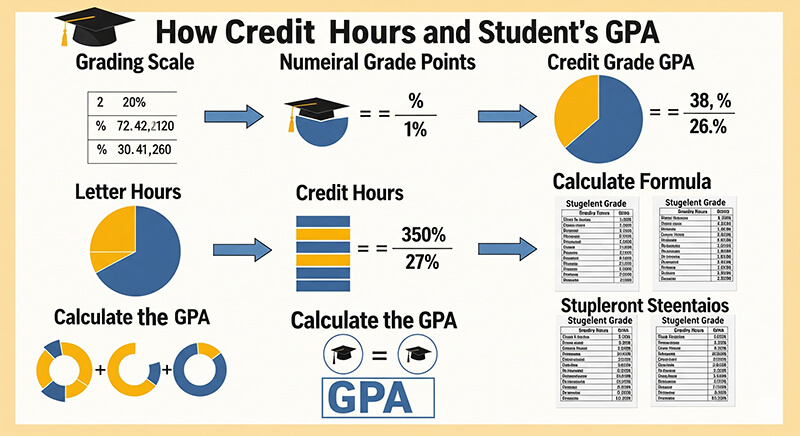Key Takeaways
- What are Quality Points? Quality points are the numbers your school assigns to your letter grades. For example, an 'A' is often worth 4 points.
- How Do They Make a GPA? Your grade's quality points are multiplied by the class's credit hours. The total points are then divided by the total credit hours to find your GPA.
- Why Do They Matter? This method means classes with more credit hours have a bigger impact on your GPA.
- GPA vs. Simple Average: Your GPA is a credit-weighted average. A simple average just adds up your grade points and divides by the number of classes, which isn't as accurate.
Understanding Quality Points: The Building Blocks of Your GPA
Quality points are the starting point for your Grade Point Average (GPA). Think of them as the value of each grade you earn. A school uses a scale to turn your letter grades, like A, B, or C, into numbers. For example, an 'A' grade is usually worth 4 points, a 'B' is worth 3, and so on. These points are the basic pieces used to build your final GPA. Every grade you get in every class contributes a certain number of quality points to your total academic record.
The Standard 4.0 Grade Point Scale
Most schools in the United States use a 4.0 scale to assign quality points. This scale is a simple way to standardize grades. An 'A' is a 4.0, a 'B' is a 3.0, and a 'C' is a 2.0. Some schools also use plus (+) or minus (-) grades, which have their own point values, like a B+ (3.33) or an A- (3.67). While this is the most common system, some schools might have small differences. For instance, one university might value an A- at 3.7, while another might not.
Below is a table showing a typical point system.
| Letter Grade | Grade Point |
|---|---|
| A | 4.00 |
| A– | 3.67 |
| B+ | 3.33 |
| B | 3.00 |
| B– | 2.67 |
| C+ | 2.33 |
| C | 2.00 |
How Quality Points and Credit Hours Create Your GPA
Quality points alone don't make your GPA. The next step is to factor in credit hours. Your school calculates your GPA by multiplying the grade point for each course by that course's number of credit hours. This gives you the total quality points for that single class. For example, getting an 'A' (4.0 points) in a 3-credit class gives you 12 quality points for that course. After doing this for all your classes, you add up the total quality points and divide that number by your total credit hours. The final number is your GPA.
A Simple Step-by-Step Calculation
Seeing an example makes the GPA formula easy to understand. Imagine a student takes three classes in a semester.
- List the classes, credits, and grades.
- Find the grade point for each letter grade.
- Multiply credits by grade points to get quality points for each class.
- Add up the total credits and total quality points.
- Divide total quality points by total credits.
Here is how it looks in a table:
| Course | Credits | Letter Grade | Grade Point | Quality Points (Credits × Grade Point) |
|---|---|---|---|---|
| Biology | 2 | C (2.0) | 2.0 | 4.0 |
| Mathematics | 2 | B (3.0) | 3.0 | 6.0 |
| English | 3 | A (4.0) | 4.0 | 12.0 |
| Totals | 7 | 22.0 |
The student's GPA is 22.0 (total quality points) divided by 7 (total credits), which equals 3.14.
Why Credit Hours Are So Important
Credit hours show how much work a class requires. A 4-credit science lab needs more time and effort than a 1-credit gym class. The GPA system uses credit hours to give more "weight" to more demanding classes. A high grade in a high-credit course will raise your GPA more than a high grade in a low-credit course. Likewise, a low grade in a high-credit course will lower your GPA more significantly. Understanding how credit hours affect your GPA is key to managing your academic standing.
GPA vs. Simple Grade Average: A Key Difference
It is important to know that a GPA is not the same as a simple grade average. A simple average would just add up the grade points (4.0 + 3.0 + 2.0) and divide by the number of classes (3). This would give you an average of 3.0. Your GPA, however, is a weighted average that accounts for the different credit hours of each course. The GPA gives a more accurate picture of your academic performance because it reflects the intensity of your coursework.
An Expert's View: Why a Simple Average Can Fool You
As an academic advisor, I've seen students get confused by this. One student was happy with his "B average" because he got an A in a 1-credit elective and a C in his 4-credit major course. A simple average made it seem like he was doing fine. But his GPA told a different story. The C in the heavy-credit course pulled his GPA down much more than the A in the light-credit course could pull it up. This is why universities and colleges always use the weighted GPA. It shows your true performance.
What is a Good GPA? A Look at National Averages
Students often wonder where they stand. Looking at national data can provide some context. The average high school GPA in the U.S. is about 3.0, which is a 'B' average. For college students, the average GPA is slightly higher, around 3.15. These numbers are just averages, and what is considered a "good" GPA can change based on the school and the field of study. For example, science majors often have slightly lower average GPAs than majors in other fields.
Use a GPA Calculator for Fast and Accurate Results
Calculating your GPA by hand is possible, but it can be tricky. You have to keep track of every class, grade, and credit hour. Using an online tool can make it much easier. A good tool helps you avoid math mistakes and see how future grades might impact your overall average. To be sure your calculations are correct, you can use a trusted website like TheGpaCalculator.com. It helps you stay on top of your academic progress without the headache of manual calculations.
Frequently Asked Questions About Quality Points
Do all schools use the same quality points system? Most schools use a standard 4.0 scale, but there can be small variations. Some may weigh plus/minus grades differently or have different scales for honors or AP courses. Always check your school's official grading policy.
What are quality points called on a transcript? On a transcript, they might be listed as "Quality Points," "Grade Points," or "Qpoints." You will also see columns for credit hours and the final grade.
How can I increase my total quality points? To increase your quality points, you need to earn higher grades, especially in classes with more credit hours. An 'A' in a 4-credit class adds 16 quality points, while a 'C' only adds 8. Focusing on high-credit courses can have the biggest positive impact.
Is a 3.0 GPA good? A 3.0 GPA is a 'B' average and is the average for U.S. high school students and close to the average for college students. It is generally considered a solid GPA, but requirements for scholarships, honors programs, or graduate schools are often higher.

